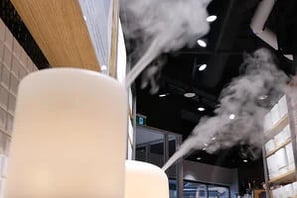How to Merchandise Your Store: 12 Visual Merchandising Tips That Work

Subscribe to our newsletter
Retail merchandising is a crucial topic! Most of the time, smart retailers call it visual merchandising and are always looking for best practices to arrange their products.
What is visual merchandising?
It’s how you present, arrange, and display products so they catch the shopper’s eye and invite them to touch, try, and buy. Done right, it’s the silent salesperson that can close the sale without a word.
Most of the time, when people ask how to merchandise their store, they’re really asking: how do I tell a story that sells? It’s easy to pile a bunch of discounted items on an endcap with a red SALE sign...but what about your full-priced merchandise? How do you make that move?
Here’s what a lot of advice leaves out: pretty displays don’t pay the rent. If your visual merchandising doesn’t convert browsers to buyers, it’s just decoration.
And dragging out clearance racks to the sidewalk won’t help either. That makes your store look more like a yard sale than a retail brand.
This all comes back to a bigger issue: Do you know how to organize your merchandise to make people stop and shop?
You don’t need to overthink it. Start with these principles.
12 Merchandising insights that work in any store
1. Change displays monthly
Seasons and holiday periods only last so long, and promotional items have a short shelf life. Rotate new arrivals in your store layout right away.
Group collections together. If you ordered products meant to go together, don't scatter them, they'll lose their impact. You don’t want their first appearance to be diluted or the potential add-on sale to be lost.
Left over stock? Combine it with new merchandise to refresh the display.
2. Highlight what customers want, not what they need
While shoppers come in with an idea of what they need, your displays need to tempt them to what they want. Don’t choose to highlight products the customer already needs.
They may come into your store and tell you they need a cheap blender, but they want the $300 KitchenAid. Merchandise the aspiration, not the necessity.
3. Group products by use or color, not just price
Price-based merchandising makes sense in a grocery store. In specialty retail, it’s lazy. Build stories: a tea-time table, a home office desk setup, or a black-red-white combo that stops people in their tracks.
4. Focus on the front of your store
Start with the display area closest to the front door and highlight your newest and most expensive items.
Lead with your newest and best. Vary the height, keep fixtures spotless, and stock them just full enough to touch without destroying the display.
5. Add a stuffed pig to at least one window...really
Place something unexpected—a stuffed pig in a kitchen display, a cowboy boot next to a luxury watch. It’s not about the prop. It’s about getting shoppers to ask, “What’s going on here?” That moment of curiosity leads to engagement.
6. Light the merchandise like it matters
You can’t sell what people can’t see. Add spotlights. Adjust overheads. Move your most important items under good lighting. A well-lit item looks more valuable. Remember, light makes the merchandise pop.
7. Add compelling signage
Add a few well-placed, well-worded signs - even on store fixtures. Ensure the signs are short and easy to read to catch customers' attention.
If your customers are mostly seniors, use larger fonts to make it easy on them. Handwritten signs with markers are okay for a kid’s lemonade stand, but they tend to look amateurish anywhere else.
Don’t ever put up signage that says DO NOT TOUCH. You might as well put up a sign that says DO NOT BUY. Displays are supposed to get messed up.
8. Rotate displays, not fixtures
Move existing displays around the sales floor when new merchandise comes in. Keep your store layout fresh. Move strong sellers deeper into the store after a couple of weeks to encourage browsing. Shuffle mid-floor displays up front. Make them work in new zones.
9. Track your sales by SKU
Monitor your computer printouts and inventory levels on a weekly basis. If something takes off, be prepared to reorder these best-selling products immediately.
If it’s not moving, try relocating the display before giving up. You’re not just merchandising- you’re testing.
10. Make sure every product in each arrangement is priced
Make sure all of your product is priced. No one wants to have to ask how much something is.No price tag = friction = lost sale.
 11. Engage more than one sense
11. Engage more than one sense
You may have seen those stores selling health aides in malls with several oil diffusers working, pictured at right.
You're probably already wondering what they smell like. That's the power of engaging more than one sense.
I've seen retailers use ScentAir for beachy Tommy Bahama clothes departments to engage the nose, high-end grocery stores to offer fine food tastings to engage the mouth, and sound retailers to have separate rooms to engage the ears.
Add scent carefully. Sample food if you sell it. Let customers hear what a speaker sounds like or feel what a jacket feels like. The more senses involved, the more memorable the experience.
Just make sure to go easy on scent. Many people have allergies or other preferences.
12. Add motion to your display
Movement grabs attention. Use a fan to make a dress ripple, a rotating display base, or a looping video. Movement draws the eye—and the ear.
Or, check out a company that works with in-store media for retailers.
See also: How to craft a retail merchandising plan with this comprehensive primer
What’s New: Merchandising Has Gone Digital Too
That doesn’t mean throw out the old rules. But if you want to compete today, you can’t ignore the new tools available.
Retail Media Networks
Your website, app, or even your in-store screens can do more than just show product. They can generate revenue. That’s what a retail media network does: it lets vendors pay you to advertise in your ecosystem.
Think of it like turning your endcap into a billboard, but with data behind it. You know what your customers shop for. Use that to give vendors a better way to reach buyers.
Try this: Take your highest-traffic display, add a screen, on a prominent shelf. Offer that space to a key brand for a small promotion. Use it as a test. Measure the lift. You’ll see the potential fast.
Artificial Intelligence
You don’t need a robot in your store to benefit from AI. It’s already baked into your POS, your CRM, and your reporting tools.
AI can tell you:
-
What items to move forward based on sell-through
-
What colors or categories are rising
-
When to reorder to avoid stockouts
Try this: Run a report on your top-selling SKUs by location. Move those items to better display spots this week. That’s data-powered merchandising.
If You Only Took One Action This Week...
Here’s where most retailers freeze up: they think they need to “digitally transform.” You don’t. Just take one step.
- Try one vendor ad.
- Use one AI-generated report.
- Make one display decision based on something other than guesswork.
Just start.
The most important element of visual merchandising
It’s not the fixtures, or the lighting, or even the display plan. It’s your creativity. That’s the piece no algorithm can replace.
Use these tips to establish a solid foundation. However, remember that merchandising is a living entity. Keep experimenting. Keep testing. And most of all, keep your customer at the center.
Finally, ensure that your floor plan remains open and that aisles are easily navigable. Customer service extends to the ease with which they can navigate around your stellar displays.



